In the previous introduction and article on cycles I covered ground that will be familiar to many. In this article I want to look at Hadley cells and start to consider other ways the planet might operate.
See also:
- Introduction
- Criteria for Cycles
- Global warming and earthquakes
- Thermal crust expansion, decomposition and the Carbon cycle
- Overview of feedbacks
- Climate stability
- Hitting the buffers
- How CO2 could control climate
- Drying of climate
- 5million years of cycles
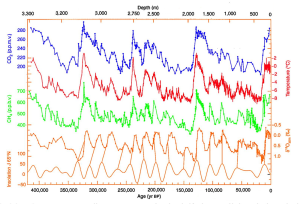
Fig. 20 Vostok ice core showing CO2 (blue), proxy temperature (red), CH4 (green), %O18 (upper brown), Insolation (lower brown)
Most people reading this, whatever their view on climate, will be familiar with the concept of an ice-age and most will understand how the Vostok ice cores (fig 20 right) shows details of the last four cooler periods with their warmer interglacials.
However, where we may start to find differences is looking within this Vostok data where CO2 and temperature appear to rise and fall together and whether this is cause and effect and which if either is the cause. However, few will disagree that whilst CO2 might on its own cause modest heating, this in no way explains the change from ice-age to interglacial. So, to fit this square peg of a very small impact of CO2 into the round hole of massive temperature change a variety of forms of massive positive feedback mechanisms have been postulated to explain how a relative small change in CO2 might just have caused enough temperature change to produce the above graphs. But is this the dog waggling the dog? Could it be that CO2 changes in response to temperature. But if change of CO2 during the ice-ages were responsible for the change in temerpature, then this certainly would suggest (at face value) that rising CO2 today would have a much greater effect.
And now:-
I’m now going to present a theory that in large part supports that view
[As I detailed in my previous article “Now I’m a CO2 denier“, I failed to fulfil this intention because CO2 is not correlated with temperature around 16,000 years after the inter-glacial peak.]
But please read on, because far from agreeing with this theory that says that further warming is highly unlikely as a result of CO2 rising I will be concluding [true] that we are very unlikely to see further warming!
But before doing that I will look at Hadley cells:

Fig 21. Hadley cell structure of the atmosphere showing three zones to north and south of equator with winds in opposing directions in each cell
Hadley Cell Structure
To the right is the typical views of the “Hadley” cell structure of the world’s climate. Looking at the northern hemisphere, we see that air rises at the equator due to the strong solar heating where the sun is overhead. (Also this air is humid and less dense). This makes the equator a low pressure region which draws air in from the North (and south) at surface level, this rises, the air cools and water is precipitated as rain over the tropical equatorial jungles, and then the cooler drier air is pushed out from the equator at the top of the troposphere by new rising air.
This air, now moving above or at the cloud level, is above most of the blanketing atmosphere and so relatively rapidly loses heat to space (aided by so called “greenhouse gases” which at high altitude have a cooling effect). Having lost heat firstly by precipitation and then by IR emission and also because drier air is heavier per volume, eventually this colder-dry air begins to descend. In the three cell Hadley structure this occurs over the Sahara and other desert regions located equidistant to the north and south from the equator. This descending cold-dry and so dense air creates a region of high pressure. High pressure as we know is cloudless, so as it moves out from these desert regions it picks up warmth, then as it reaches wetter areas, it starts to pick up moisture until at the equator the air rises, the water precipitates and the cycle repeats.
Going up to the Poles, we see areas with very little solar heating. So, heat is lost by IR emissions predominantly from the top of the atmosphere where greenhouse gases help cooling. This colder, denser air descends making the poles a high pressure zone. This high pressure pushes air out at surface level allowing high altitude air which is warmer that the descending air to be drawn in until it in turn cools.
So, poleward moving surface air cycles are created at the poles and equator driven by solar heating at the equator and IR cooling at the poles.
Finally, because we have two areas of high pressure, one at the pole and one over the desert regions, the air from each is pushed toward the latitude of the UK. As it crosses over the earth’s surface, the Sahara air mass picks up humidity and becomes warm-wet, and the Polar air flow picks up only modest amounts of heat and moisture to become cold-dry. When they meet, we get turbulent weather systems. Polar air gains heat and rises, Sahara air looses moisture and gains enough heat to rise allowing a three Hadley cells to develop.
Are other Cell Configurations possible?
There are two main constraints on the Hadley cell structure:
- Air is heated most of the equator so there must be rising air at the equator (or more exactly where the sun is most intense as this moves with the time of year)
- Air is heated least at the poles so, this is where we must see descending air.
But in between the pole and equator, there doesn’t seem to be any obvious fundamental reason why there could not be other configurations:
As a physicist I could not help notice the similarity of lasers or indeed electrons in an atoms. Whereby the laser or atom is in one state, but can sometime spontaneous change its configuration. So why not with the Hadley cells? It seemed to me that the three Hadley cell structure was an entirely arbitrary number and therefore it was entirely conceivable that there could be five, seven or nine cells, or indeed 1. The only basic requirement was that air should descend at the pole and rise at the equator.
So, I began to wonder whether there might indeed have been other configurations in the past and the most obvious one seemed a single Hadley cell.
The effect of a single Hadley Cell
To understand how changing the number of Hadley cells would affect the climate we first need to understand the relationship between ocean currents and trade winds.
Below is a map of trade winds over which I’ve marked the predominant flows.
Comparing that diagram to the Hadley Cells, we see it has the same tropical winds and the Hadley cell also as westerly winds at the latitude of the UK. And whilst less clear, there is a general movement of air toward the equator and toward the latitude of the UK. If now we superimpose that broad wind with the ocean currents:
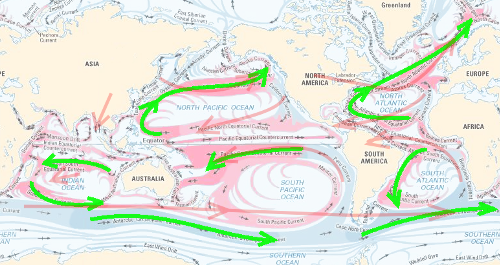
Fig24. Showing close relationship between main ocean currents shown in green and main trade winds shown in red. Ocean currents are darker where strongest.
Looking at the fig 24, we can see that the main trade winds (red arrows) closely match the main ocean currents (green arrow) except where the presence of land-masses (e.g. China) make it impossible for the ocean current to follow the trade wind.
There is a broad east to west current flow at the equator corresponding with the east-west equatorial winds and there is also a second group at the latitude of the UK both in the pacific and Atlantic where warm water heads westward. But if the current’s path is blocked by land, the current turns away from the equator. This happens along the equator on the east coast of America, Australia and the shallow seas to the north and on the east coast of Africa.
But at the latitude of the UK, the currents move not eastward but westward and here it also turns north when it hits America (Pacific) or the UK (Atlantic). Similarly in the southern hemisphere, there is a westerly current flowing around the Antarctic, but with no landmass in its path and Antarctica preventing southerly flow, the current continues its circular path.
However, whilst the winds and currents tend to match it is not as simple as that. If we look at the Pacific currents both winds and currents are strong moving eastward. But whereas the winds are strongest where they head toward the equator, the strongest currents continue moving away from the equator.
Generally the currents flow around in a circular flow. This should mean the current is equally strong all around the circuit, but it is not. In fact, the strongest currents are always warm water currents heading away from the equator . These occur on the east coast of Africa, China and America both south and north of the equator where water flowing eastward heads away from the equator along the shores. The least pronounced are cold water currents heading toward the equator

Fig 25 Gulf Stream shown as hot (red) toothpaste like stream coming out of Gulf of Mexico and heading NE until it disappears.
Warm water floats
The reason the warm water currents moving away from the equator are strongest is simple: warm water is less dense and so floats. The best known example of such a warm water current is the Gulf steam which is readily seen on an IR Satellite image to the right as a toothpaste like squiggle of read against the darker colours of the Atlantic. The Gulf stream (not to be confused with the general North Atlantic Drift) is in fact a very small current. It arises because of easterly winds pushing hot equatorial water into the Gulf of Mexico and this forces this “toothpaste” like current out between Cuba and Florida. Being much hotter than the Atlantic waters in this area, the hotter Gulf stream readily floats at the surface until it looses its heat and disappears into the general North Atlantic drift.

Fig 26 Currents in the North Atlantic showing how warmer currents float over colder currents source
To the right is an overview of this North Atlantic current showing how the warmer waters float on the surface as they move northward, and float over the colder returning water. The result is that the the warmer northward heading currents tend to dominate the sea surface.
In the mid latitudes, in a three Hadley cell climate, the northerly direction of the mid latitude winds forces warmer water from the equator northward which tends to float.
So, the mid-latitude Hadley cell has northerly going surface winds which push along the northerly going sea currents. And if the wind should die or tend to change directly, the momentum of northerly going sea currents will tend to push the wind along. So the two work in the same direction and tend to enhance each other.
However, it all falls apart in a single Hadley cell climate.
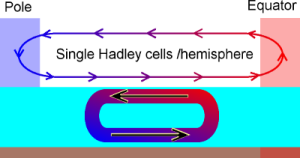
Fig 28. The warm surface currents still tend to flow equator to pole, but the surface winds flow pole to equator
If the climate were to start operating as a single Hadley cell, now the winds at the pole and equator are the same (so we ignore the currents here), but the winds in the mid-latitudes are from pole to equator. However, because the warm water is at the equator, and it tends to float on top of the colder return currents, the current flow will tend to have warm surface currents heading poleward which are in opposition to the winds. Now, instead of the currents and winds tending to work together, the two are in opposition. The wind tends to slow down the current, and the current tends to slow down the wind.
The switch between 3 and 1 cell
And therefore if the climate started to operate as a single Hadley cell, the situation would be self re-inforcing. The mid-latitude currents would dramatically reduce in intensity because the warm water is no longer flowing in its preferred direction away from the pole and the result would be to dramatically reduce the heat flow toward the latitude of the UK where this heat is needed to keep the 3-Hadley cell going. Because it both warms the polar air allowing it to return to the pole and it warms Sahara latitude air allowing it to return to the Sahara.
Therefore the single Hadley cell climate will cut the heating in the critical area of the UK causing substantial cooling at these latitudes and enhancing the likelihood of a single Hadley cell climate continuing.
And if the system were to (relatively) sudden switch, we would see a very different distribution of heat. (And likewise if we went from a 3 to a 5 cell Hadley structure for the climate.)
As such the combination of trade winds and ocean currents could provide the necessary conditions for positive feedback in the climate leading to a bi-state (or even tri-state) climate where “catastrophic” cooling might occur going into an ice and “catastrophic” warming coming out.
See also:

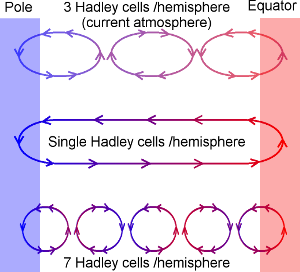
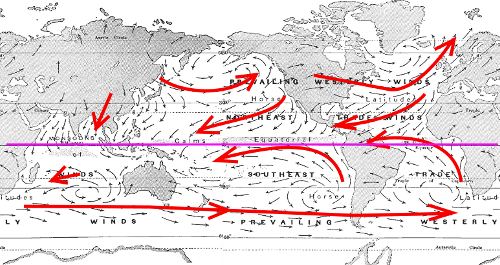
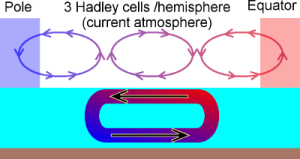

This is a fascinating idea. I need to think about it more. Does not explain the oscillatory trigger points but could explain a two node climate strange attractor, which we evidently have had during the Pleistocene.
But since oceans are the main heat conveyor from the tropics, not sure any atmospheric phenomenon is an underlying ‘trigger’. In Scotland, you should be very grateful for the Gulf Stream that emerges from the Gulf of Mexico through the Florida straits. It warms the climate of all northern Europe.
Hadley cell change is actually pretty likely, but also likely more chaotic. If you have a limit of say 28-29C as the maximum tropical sst range, the width of the tropical warm water would expand. If the hemispheres were uniform, the expansion would be uniform, but they aren’t so you have more warm water expansion into the NH than the SH. This is the major impact of the Drake Passage opening/ Panama closing, they imbalanced the hemispheres as far as pole ward energy transfer. With extremely uniform ocean waters expanding north, there would like be shifts from Hadley-Ferrel-polar cells to super Hadley-super polar trying to become one huge Hadley to the poles, in areas with southward expanding glaciers. That should tend to self destruct pretty quickly reverting to the “normal” Hadley-Ferrel-Polar arrangement. I believe there is a paper on that but I can’t remember the author or if it was specifically related to glacial periods.
The only caveat is that Coriolis forces do not favour large cell structures. I glossed over this because theoretically (in a frictionless system) we shouldn’t get a 3/6 cell configuration. That suggests angular momentum is being removed from the system through surface friction.
And so as I’ve no way to estimate how much angular momentum is removed by surface friction, I’ve no way of knowing whether a 1/2 cell configuration is possible.
So, my final summing up talks about the system being “sensitive” without going as far as to suggest it changes completely.
However, nor can I rule out a system moving toward 5/10 configuration.
Hadley cells suggest a uniform system all the way around the world. This is a false model because as you say the system is chaotic. I would suggest that we may regularly see parts of the global with patterns of wind that already match the 1/2 Hadley cell configuration. So, as you suggest it’s chaotic. I would think that if this occurs it would be less that we switch completely and more that we see a general tendency to see more and more of the world’s wind patterns fitting one patter rather than the other and particularly at different seasons as the sun moves north-south.
right, and due to the precessional cycle you have hot NH, Hot equ, Hot SH and back to Hot equator. So instead of a di-precessional energy “tide” you have a semi-di-precessional energy “tide”. During the two hot equator phases you should have closer to “ideal” Hadley circulation. A lot of paleo reconstructions indicate roughly 5000 yr pulses related to precessional or obliquity cycle depending on the author’s interpretation.
The transition from hot equator to hot/cold pole impacts each hemisphere differently creating the “SeeSaw” pattern in paleo. Since the SH has more stable ice, 65S has less impact than 65N maximum insolation.
However, if enough land based ice hasn’t accumulated, 65N wouldn’t have as much impact and since land based ice can grow to be unstable on its own, 65N max insolation isn’t always required for a deglaciation or partial deglaciation.
On a smaller scale ENSO also has a semi-di-annual solar energy “tide”. This creates a problem since while ocean tides are easily understood a similar energy “tide” isn’t. Which is a bit odd, tides are “chaotic” but accepted while erratic behavior of glacial cycles due to a similar phenomenon isn’t.
hadleigh = Hadley (spelling)
btw Scottish, this is a brief outline post on my take on thermal “tides”.
http://redneckphysics.blogspot.com/2015/02/chaos-and-tides.html
You can use anything you like.
Thanks Dallas. One of the reasons I considered a change in the Hadley cell structure was that the scale of change we see entering and leaving the ice-ages is difficult to explain without some big change like this.
And if a small amount of cooling led to a change in the cell structure that created a massive amount of cooling, this explain why the climate is so sensitive from about 50% to 80% of the temperature change.
The key, I think is that the North Atlantic drift is not only driven by the Hadley cell, but it is also probably key to the strength of the cell. So, a decline in Hadley cell would tend to reduce the strength of the Hadley cell, reducing the north Atlantic drift reducing heat. And if you got into a 1/2 structure, it would seem to be reinforcing so it would tend to stick as the dominant pattern – unless or until, you had a sustained period of winds to start the North Atlantic drift going again.
My own view of Enso and other oceanic cyclic currents is that they are probably resonators responding to and amplifying specific frequencies of natural variation. You get a very similar effect on a ferry – the engine noise will start to make parts vibrate and then because they go out of phase, the noise stops and then it recurs – on a very regular pattern.
However, another model would be a series of pendulums on a piece of string. What tends to occur, is that one pendulum starts to swing, and then that energy is transferred to others and then they in turn transfer to others. So, each pendulum ends up swinging in a chaotic manner even though the total energy is largely constant (small decay).
Oh &%$%!!
Thanks. No idea where that came from – I just seem to have suddenly started using the wrong spelling.
That’s a very interesting way of putting it. As I posted just now (perhaps not here so I’ll repeat) I view ENSO, PDO NAO as being like resonant circuits with loose connection. In effect a line of weights each tied to one main string.
But I’ve not considered heat as itself creating a physical property – but clearly expansion and change in density can have a similar effect to water level as per the normal tide.
What I really need is a set of figures of the total energy in various systems on the planet and how long they would take to change subject to e.g. a 1C change.
… however it’s valentine’s day.
“its valentines day”
Definitely a more productive use of your time 🙂
The Thermal tides things is definitely not a slam dunk. Unlike ocean times, the thermal reservoir tends to lose energy so it may only be useful near peak inter-glacial conditions.
http://redneckphysics.blogspot.com/2015/02/the-thermal-tidal-basins.html
That explains my take on the basins of interest and how much is involved in finding a reference to work out from.
Pingback: Toward a new theory of ice-ages XIV (Putting it all together) | Scottish Sceptic
I’ve been thinking along similar lines, without the benefit of a physics education, since I read these
http://www.math.ualberta.ca/ami/CAMQ/pdf_files/vol_17/17_1/17_1e.pdf
http://slideonline.com/presentation/6848-hadley-cell-expansion-langford-pdf
I may comment further when I’ve read through the series.
I’m having difficulty with this paragraph
“And therefore if the climate started to operate as a single Hadley cell, the situation would be self re-inforcing. The mid-latitude currents would dramatically reduce in intensity because the warm water is no longer flowing in its preferred direction away from the pole and the result would be to dramatically reduce the heat flow toward the latitude of the UK where this heat is needed to keep the 3-Hadley cell going. Because it both warms the polar air allowing it to return to the pole and it warms Sahara latitude air allowing it to return to the Sahara.”
Sould away be towards? or pole be equator?
Given a persistent NEasterly wind, would that push the warm ocean current up against the coast of Greenland, and would this lead to a fresh[er] cold water surface current [from siberian rivers] exiting the Arctic against the coast of Norway and hugging the west European coastline?
My argument is as follows:
In order to drive the cycles we need a heat source and because they are heat engines we also need a heat sink.
Therefore if we consider the northern most Hadley cell from the UK to the N.Pole, there must be a source of heat going into that cell to cause it to occur.
The obvious source of heat is the north Atlantic drift (often call the “gulf stream” but this is actually the current out of the Gulf of Mexico).
The North Atlantic drift is largely driven by the prevailing wind – which in a 3 cycle Hadley drives the current northward. And because warm water floats over colder water, the effect of northward wind is to create a surface layer of warm water that reaches the UK where it powers the Northern Hadley cell (but notice how little sea there is at this Northern latitude!!!)
If however we had a 1 cell (or 2 – one north one south), then the winds in the centre cell reverse.
Now instead of driving warm SURFACE water to the north, they drive cold water south. But because this cold water sinks as it reaches warmer seas, this is not a surface current but is a overturning of the whole ocean depth.
The difference is that the hotter the surface water going north the lighter it is compared to the rest of the ocean and the more it is confined to the surface where the effect of the winds are strongest, so the harder it gets pushed northward. In contrast, winds moving south tend to cause water to reach areas where it is colder than the surface waters (so it is more dense) – so these surface waters act as a buffer tending to push back against the current (and forcing it downwards).
This means winds heading north tend to create one massive cycle and so are far more effective at pushing warm water north. In contrast winds pushing southward are likely to create smaller more localised cycles.
ADDENDUM:
What I’m also suggesting is that “too much” heat in the area of the UK, tends to disrupt the single Hadley cell by causing air to rise. And once the air starts rising – this then tends to create low pressure which then starts sucking in surface wind and currents. If this rising air continues long enough, the momentum of the sea will then make it very difficult to break this cycle because even a relatively long period of high pressure would not stop the ocean currents.
However, perhaps if a freezing surface or prolonged cold period occurred this might disrupt the weather for long enough to “switch off” the ocean current, stop the heat being brought in to drive the Hadley cell and effectively switch it off.
I’d suspect the latent heat released by condensing water vapour to be a substantial source of heat near the UK, given how much it rains.
Some weight needs to be given to salinity when considering which water floats/sinks, the warm water flowing north becomes much denser [evaporation] and the flow from the arctic is much fresher and lighter.
What I was suggesting above was that if the system switched from a 3 cell to a single cell there would remain a lot of inertia at play. The new prevailing wind would indeed stop the gulf stream heading to Europe, and could drive it south again or force it to flow up the east coast of America/Greenland effectively switching the in-outflow from it’s present pattern to the opposite. Take a look at the SSS and SST 30day gifs here http://www7320.nrlssc.navy.mil/hycomARC/arctic.html. The question is how would this affect the arctic? Would Siberia be bathed by warm ocean currents? Well luckily there’s a 3.6m year old meteor crater lake with sediments to help with that http://www.geo.umass.edu/lake_e/index.html
Pingback: A complete explanation of the ice-age cycle. | Scottish Sceptic